Unit 7 Seasons Grammar 课件(共38张PPT;无音视频)
文档属性
| 名称 | Unit 7 Seasons Grammar 课件(共38张PPT;无音视频) | 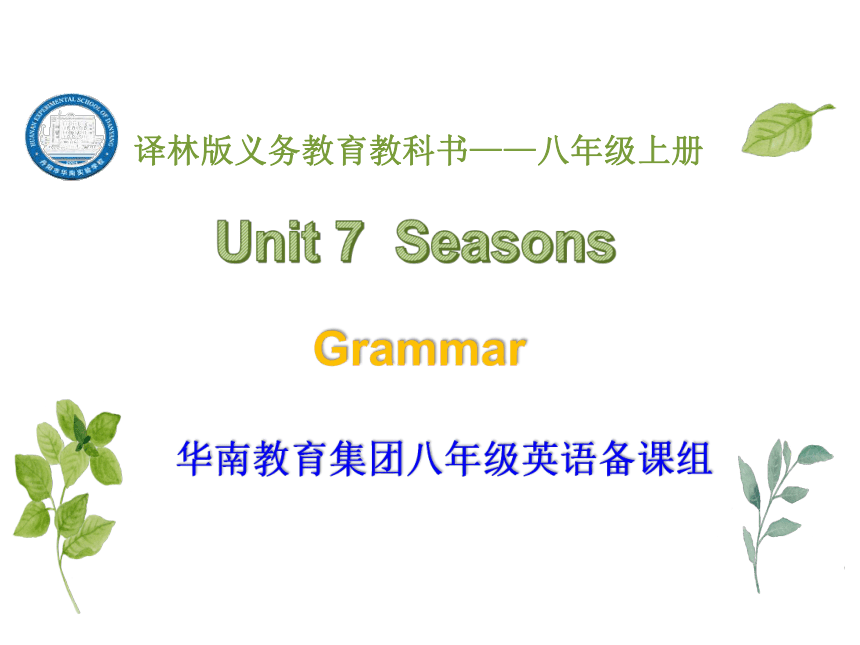 | |
| 格式 | pptx | ||
| 文件大小 | 2.6MB | ||
| 资源类型 | 教案 | ||
| 版本资源 | 牛津译林版 | ||
| 科目 | 英语 | ||
| 更新时间 | 2021-08-24 10:10:08 | ||
图片预览

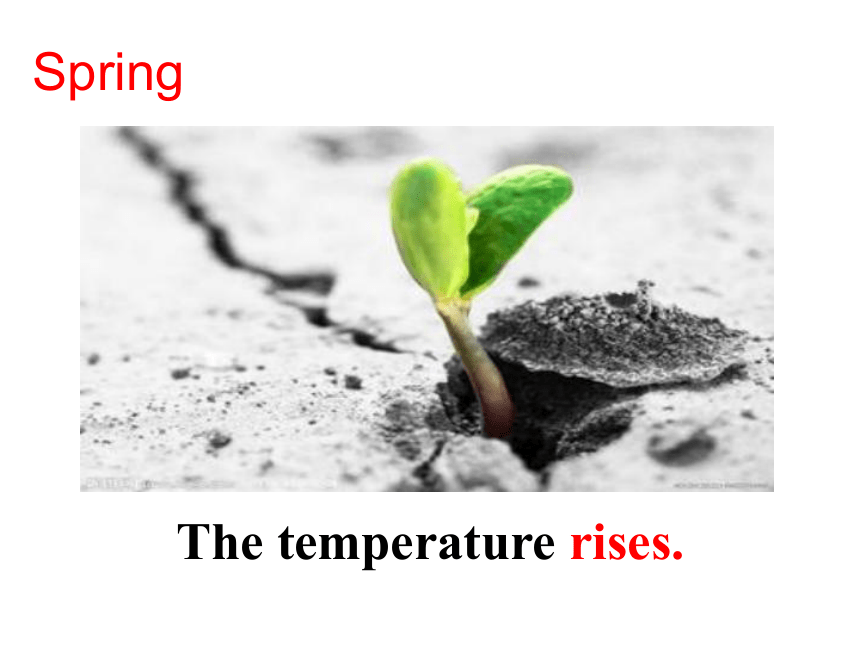
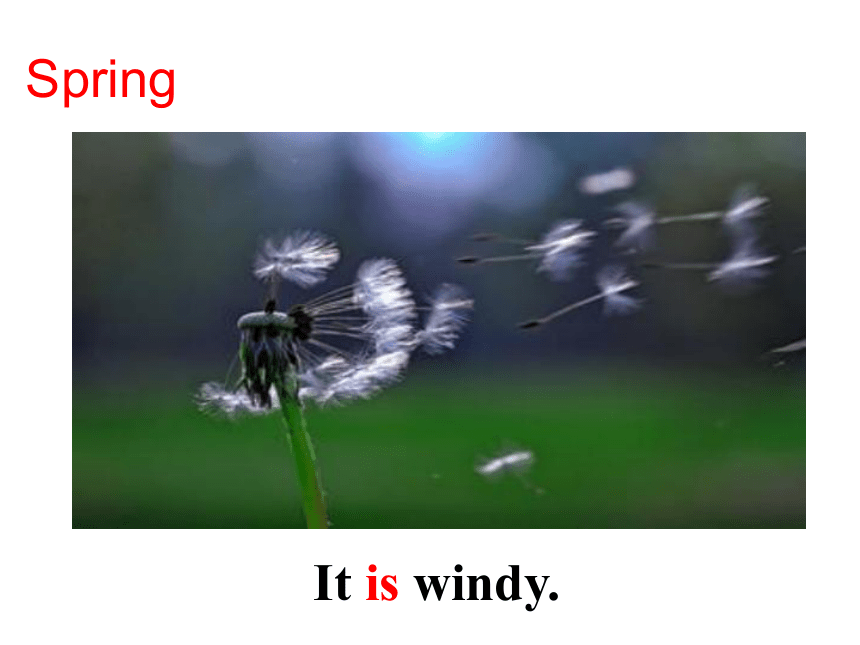
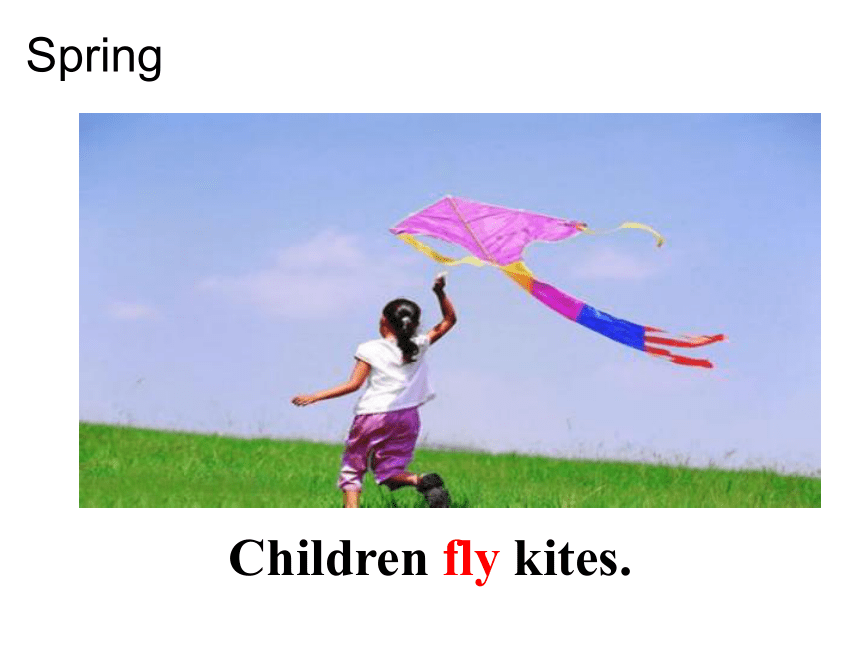
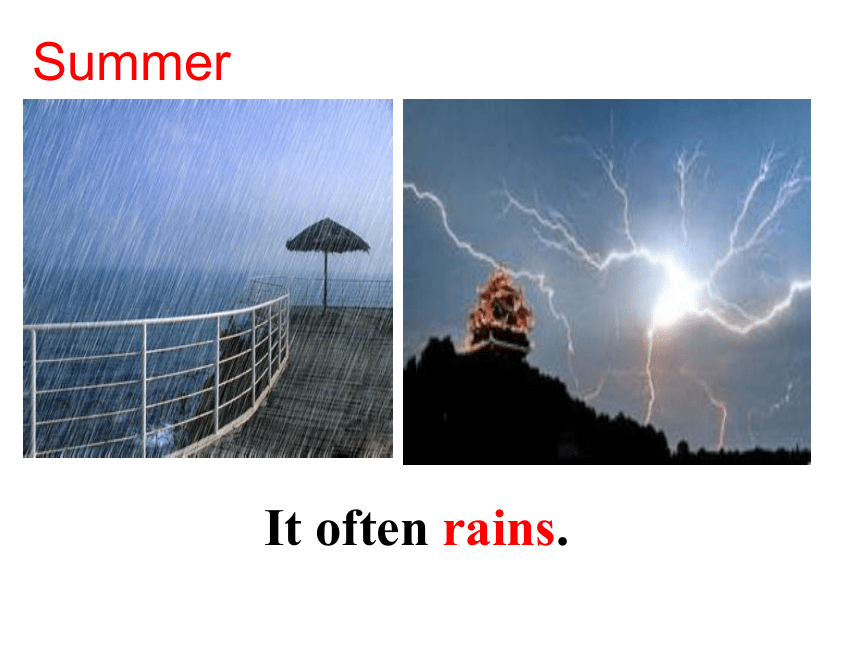
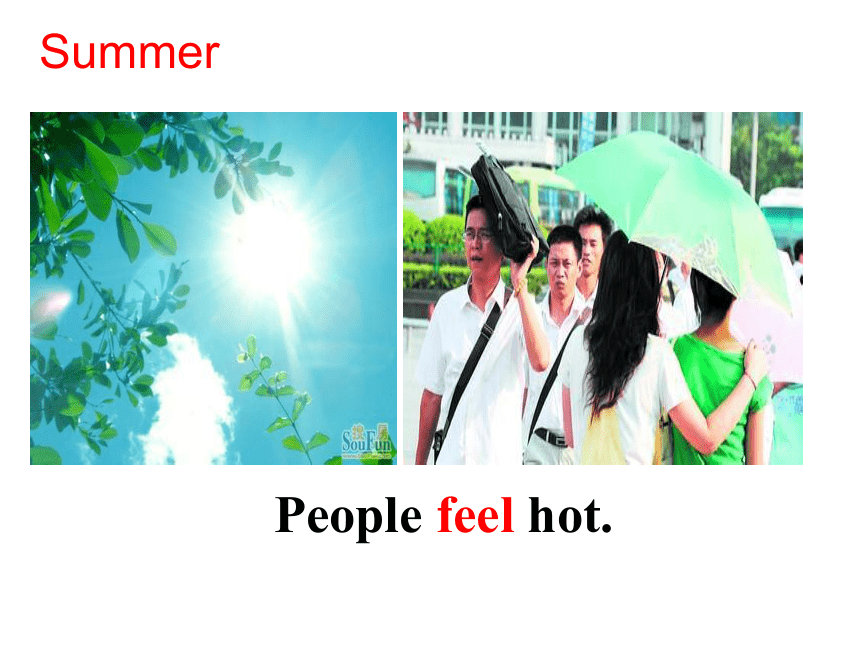
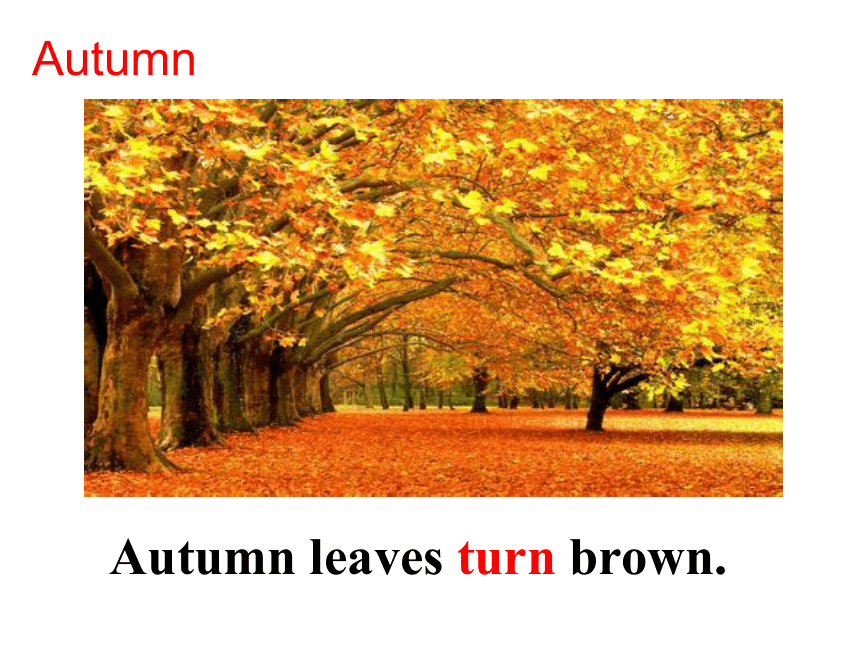
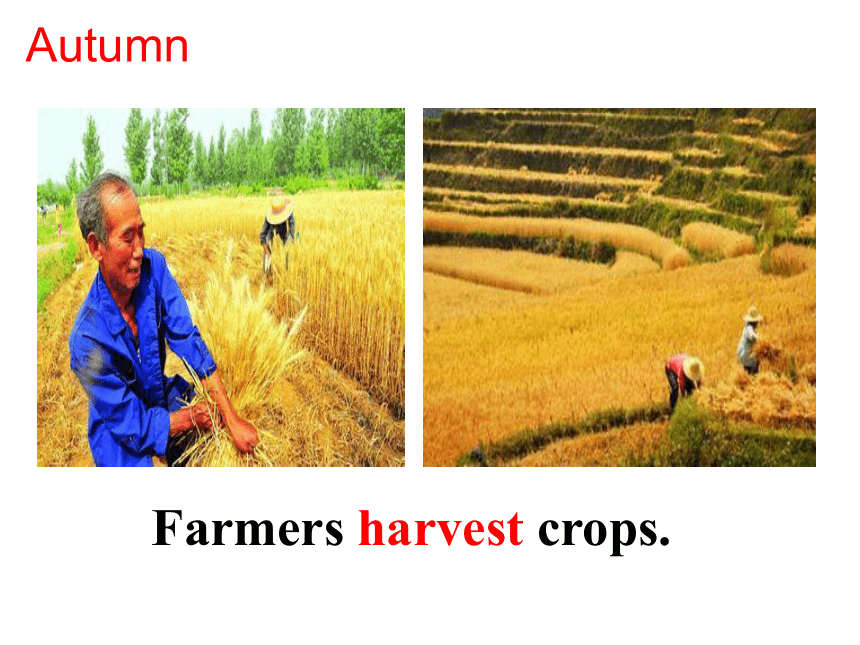
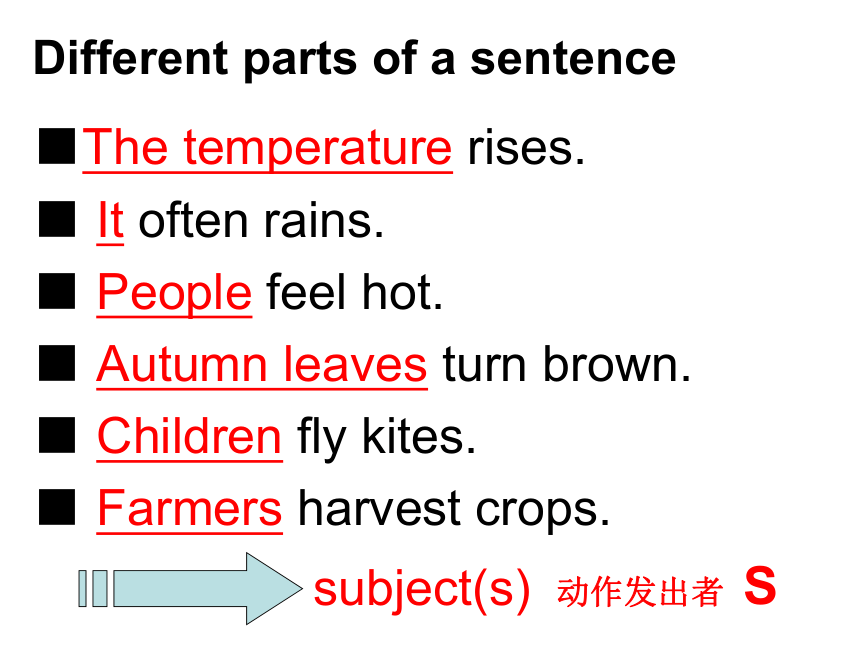
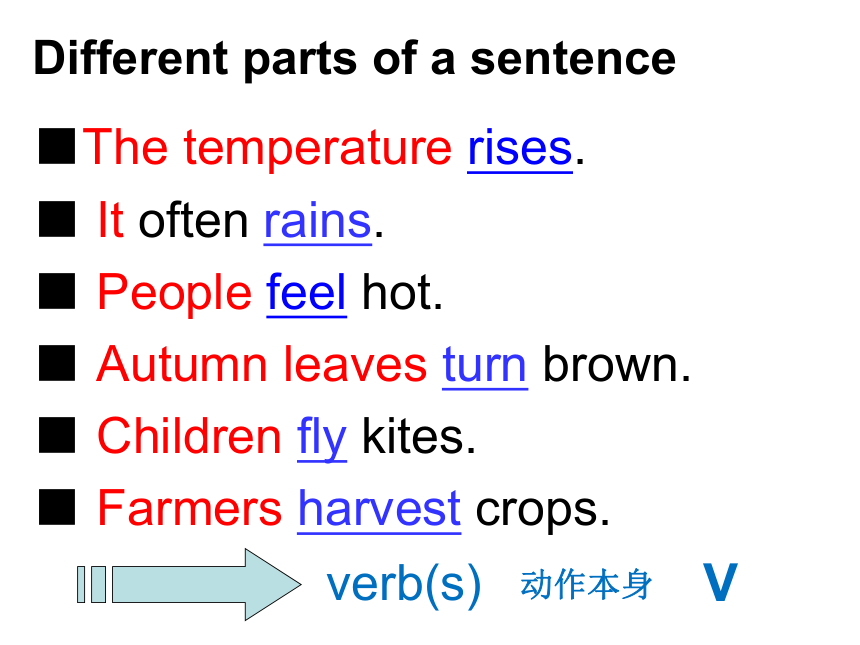

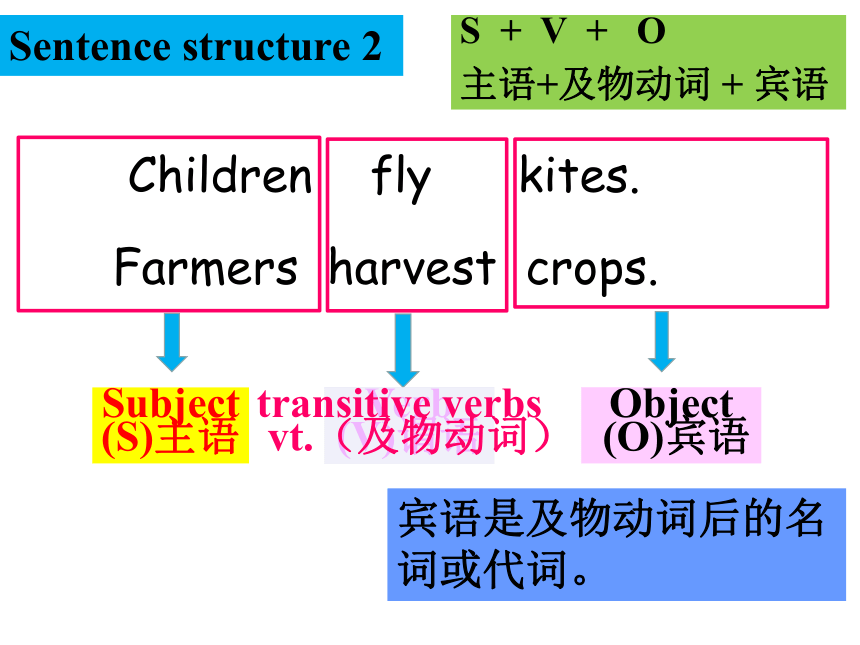
文档简介
(共38张PPT)
Unit
7
Seasons
华南教育集团八年级英语备课组
译林版义务教育教科书——八年级上册
Grammar
Spring
The
temperature
rises.
Spring
It
is
windy.
Spring
Children
fly
kites.
Summer
It
often
rains.
Summer
People
feel
hot.
Autumn
Autumn
leaves
turn
brown.
Autumn
Farmers
harvest
crops.
■The
temperature
rises.
■
It
often
rains.
■
People
feel
hot.
■
Autumn
leaves
turn
brown.
■
Children
fly
kites.
■
Farmers
harvest
crops.
subject(s)
Different
parts
of
a
sentence
动作发出者
S
■The
temperature
rises.
■
It
often
rains.
■
People
feel
hot.
■
Autumn
leaves
turn
brown.
■
Children
fly
kites.
■
Farmers
harvest
crops.
verb(s)
Different
parts
of
a
sentence
动作本身
V
The
temperature
rises.
It
rains.
Sentence
structure
1
S
+
V
主语+不及物动词
Subject
(S)主语
Verb
(V)谓语
主语是陈述句句首的名词、代词、短语或句子。
谓语是陈述句中主语后
的动词。
intransitive
verbs
vi.
(不及物动词)
Farmers
harvest
crops.
Children
fly
kites.
Sentence
structure
2
S
+
V
+
O
主语+及物动词
+
宾语
Subject
(S)主语
Verb
(V)谓语
Object
(O)宾语
transitive
verbs
vt.(及物动词)
宾语是及物动词后的名词或代词。
S+V和S+V+O的注意点
1.They
are
running.
2.Jim
can
draw.
3.The
baby
pandas
drink
milk.
4.She
will
read
English.
run
draw
vi.(不及物
动词)
drink
read
vt.
(及物动词)
注意:
1.谓语(V)具有各种不同时态;
进行时;情态动词;现在时;
以及将来时
2.
在句中先找主语
(S)
再找谓语(V)
如是不及物动词,其后不能直接加宾语
如是及物动词,其后可以加宾语。
其后有没有宾语是S+V和S+V+O判断标志
3.
如果对宾语提问使用疑问词what.
→1.
S
+
V
→2.
S
+
V
+
O
What
do
the
baby
pandas
drink?
What
will
she
read?
People
feel
hot.
Autumn
leaves
turn
brown.
linking
verbs
(连系动词)
Sentence
structure
3
S
+
V
+
P
主语+连系动词
+
表语
Predicative
(P)表语
表语位于连系动词之后,说明主语的性质,特征,状态等。
=
S
V
常见的连系动词
1.表示感觉的动词5个---翻译为
…起来
feel感到
excited;
smell
good;
taste
delicious;
sound
interesting;
look
happy
2.表示变化的动词:有固定的搭配
get
smaller;
grow
older;
become
stronger;
turn
yellow;
go
bad;
come
true
3.表示状态保持的动词:
stay
healthy;
keep
warm;
leave使…处于某种状态
be
(am,is.are,was,were)是
;seem似乎
1
The
man
is
in
the
park.
2
He
looks
kind.
3
He
is
a
kind
man.
4
The
singing
of
birds
sounds
beautiful.
5
The
world
will
become
better.
lv
lv
lv
lv
lv
P(介词短语)
P(adj)
P(adj)
P(n名词短语)
P(adj形容词比较级)
表语
P成分可以是
名词,形容词,介词短语(名形介)
She
often
laughs.
2.
She
is
laughing
now.
3.
She
will
laugh
soon.
4.
She
is
singing
happily.
She
is
singing
a
song.
She
is
a
singer.
She
is
happy.
(S
+
V+O)
(S
+
V)
(S
+
V)
(S
+
V)
(S
+
V)
注意:
现在进行时的谓语与主系表结构的区别:
关键要看be动词后接的
是实义动词现在分词形式
还是表语(名形介).
(S
+
V+P)
happily
adv修饰动词sing
a
song
是名词做动词sing的宾语
a
singer
名词表语
happy
形容词表语
一般现在时
现在进行时
一般将来时
谓语(V)具有各种不同时态
1.
We
have
four
seasons.
S
+
V
+
O
2.
They
are
quite
different.
S
+
V
+
P
3.
Spring
is
warm
and
sunny.
S
+
V
+
P
4.
We
fly
kites.
S
+
V
+
O
Finish
the
exercises
on
Page
85.
5.
We
like
summer.
S
+
V
+
O
6.
Ice
cream
tastes
nice.
S
+
V
+
P
7.
Autumn
arrives.
S
+
V
8.
Snow
falls.
S
+
V
Hobo
brought
Eddie
his
clothes.
Hobo
built
Eddie
a
tent.
Hobo
brought
Eddie
his
clothes.
indirect
object间接宾语
direct
object直接宾语
IO间接宾语
DO
S
+
v
+
+
Hobo
brought
his
clothes____
Eddie.
to
sb.
Sth.
直接宾语
Sentence
structure
4
S
+
V
+
IO
+
DO
主语+动词+
间接宾语+
直接宾语
Hobo
built
Eddie
a
tent
.
indirect
object
direct
object
IO
DO
S
+
v
+
+
Hobo
built
a
tent____
Eddie.
for
Sentence
structure
4
S
+
V
+
IO
+
DO
主语+动词+
间接宾语+
直接宾语
We
can
change
the
structure
S+V+IO+DO
with
to.
e.g.
Hobo
gave
Eddie
some
ice
cream.
Hobo
gave
some
ice
cream
to
Eddie.
verbs
can
be
used
with
to:
bring
give
hand
lend
offer
pass
pay
post
read
sell
send
show
take
teach
tell
write
We
can
change
the
structure
S+V+IO+DO
with
for.
e.g.
Hobo
built
Eddie
a
tent.
Hobo
built
a
tent
for
Eddie.
verbs
can
be
used
with
for:
bring
build
buy
cook
find
get
leave
make
order
pick
save
I
pass
He
bought
him
a
book
his
son
a
present
IO
DO
IO
DO
to
for
双宾语结构中有两个宾语,判断标准是
可否将两个宾语顺序替换并加介词to/for
S
+
V
+
IO
+
DO
主语+谓语+直接宾语+间接宾语
加to:
bring/
give/
offer/
pass/
show/
sell/
tell/
send/
lend/
return/
hand
加for:
buy/
choose/
draw/
make/
order/
paint/
sing/
save
Hobo
watched
Eddie
put
on
his
clothes.
Eddie
asked
Hobo
to
bring
the
clothes.
Eddie
asked
Hobo
to
bring
the
clothes.
S
V
DO
直接宾语
OC
(object
complement)
宾语补足语
宾语补足语用来描述宾语,补充说明宾语的情况。
(Hobo
brings
the
cclothes)
Sentence
structure
5
S
+
V
+
DO
+
OC
主语+动词+
直接宾语+
宾语补足语
Hobo
watched
Eddie
put
on
his
clothes.
(Eddie
puts
on
his
clothes.)
S
V
DO
直接宾语
OC
宾补
Eddie
asked
Hobo
to
bring
the
clothes.
常见的可接带to不定式宾补的动词有:
tell,ask,want,would
like,wish,teach,invite…
S+
V
+
DO
+
OC
(V
sb
to
do
sth)
Hobo
watched
Eddie
put
on
his
clothes.
常见的可接不带to不定式当宾补的动词有:
一感二听三让五看”
feel,/
hear,
listen
to,
/
let,
make,
have,
/look
at,
see,
,
watch,
notice,
observe(观察)
S+
V
+
DO
+
OC
(V
sb
do
sth)
He
keeps
me
waiting.
常见的可接动词-ing形式作宾补的动词有:
Keep
和
see,hear,feel,watch,find…
S+
V
+
DO
+
OC
(V
sb
doing
sth)
A
boy
makes
him
angry
DO
OC
在DO和OC中间可否加be动词
He
is
存在逻辑上的主系表关系
We
call
the
man
David.
DO
OC
The
man
is
David.
We
often
find
him
in
the
zoo
DO
OC
He
is
in
the
zoo
We
can
add
an
adverbial
to
each
of
the
above
five
main
structures.
We
use
an
adverbial
to
show
when,
where
or
how
an
action
is
done.
e.g.
Hobo
built
Eddie
a
tent
with
sticks
at
the
beach
yesterday.
how
where
when
He
gave
me
a
book.
He
calls
me
Tom.
DO
OC
+
IO
DO
+
5.
We
call
the
panda
XiWang.
3.I
found
it
important.
1.Lily
brings
me
a
present.
2.
People
call
Zhalong
Birds’
Home.
4.Zhalong
brings
the
wildlife
an
ideal
home.
6.She
thought
the
swan
beautiful.
IO
DO
+
DO
OC
+
IO
DO
+
DO
OC
+
DO
OC
+
A
game
eg:
DO
OC
+
S+V+DO+OC
S+V+IO+DO
The
weather
in
winter
makes
me
feel
cold,
but
I
still
like
winter
best
because
Christmas
is
coming.
My
grandparents
cook
us
delicious
food.
My
parents
buy
me
gifts
and
friends
send
me
Christmas
cards.
I
think
Christmas
a
wonderful
festival.
Practice:
A
diary
about
Christmas
1
2
3
4
5
1
2
4
3
5
Pair
work:
A
weather
diary.
S
+
V
+
P
S
+
V
+
O
S
+
V
+
P
S
+
V
+
IO
+
DO
S
+
V
S
+
V
+
O
S
+
V
S
+
V
+
DO
+
OC
Adverbial
状语
1.
Review
the
five
sentence
structures.
2.
Write
a
passage
about
seasons
with
the
five
sentence
structures.
Homework
Unit
7
Seasons
华南教育集团八年级英语备课组
译林版义务教育教科书——八年级上册
Grammar
Spring
The
temperature
rises.
Spring
It
is
windy.
Spring
Children
fly
kites.
Summer
It
often
rains.
Summer
People
feel
hot.
Autumn
Autumn
leaves
turn
brown.
Autumn
Farmers
harvest
crops.
■The
temperature
rises.
■
It
often
rains.
■
People
feel
hot.
■
Autumn
leaves
turn
brown.
■
Children
fly
kites.
■
Farmers
harvest
crops.
subject(s)
Different
parts
of
a
sentence
动作发出者
S
■The
temperature
rises.
■
It
often
rains.
■
People
feel
hot.
■
Autumn
leaves
turn
brown.
■
Children
fly
kites.
■
Farmers
harvest
crops.
verb(s)
Different
parts
of
a
sentence
动作本身
V
The
temperature
rises.
It
rains.
Sentence
structure
1
S
+
V
主语+不及物动词
Subject
(S)主语
Verb
(V)谓语
主语是陈述句句首的名词、代词、短语或句子。
谓语是陈述句中主语后
的动词。
intransitive
verbs
vi.
(不及物动词)
Farmers
harvest
crops.
Children
fly
kites.
Sentence
structure
2
S
+
V
+
O
主语+及物动词
+
宾语
Subject
(S)主语
Verb
(V)谓语
Object
(O)宾语
transitive
verbs
vt.(及物动词)
宾语是及物动词后的名词或代词。
S+V和S+V+O的注意点
1.They
are
running.
2.Jim
can
draw.
3.The
baby
pandas
drink
milk.
4.She
will
read
English.
run
draw
vi.(不及物
动词)
drink
read
vt.
(及物动词)
注意:
1.谓语(V)具有各种不同时态;
进行时;情态动词;现在时;
以及将来时
2.
在句中先找主语
(S)
再找谓语(V)
如是不及物动词,其后不能直接加宾语
如是及物动词,其后可以加宾语。
其后有没有宾语是S+V和S+V+O判断标志
3.
如果对宾语提问使用疑问词what.
→1.
S
+
V
→2.
S
+
V
+
O
What
do
the
baby
pandas
drink?
What
will
she
read?
People
feel
hot.
Autumn
leaves
turn
brown.
linking
verbs
(连系动词)
Sentence
structure
3
S
+
V
+
P
主语+连系动词
+
表语
Predicative
(P)表语
表语位于连系动词之后,说明主语的性质,特征,状态等。
=
S
V
常见的连系动词
1.表示感觉的动词5个---翻译为
…起来
feel感到
excited;
smell
good;
taste
delicious;
sound
interesting;
look
happy
2.表示变化的动词:有固定的搭配
get
smaller;
grow
older;
become
stronger;
turn
yellow;
go
bad;
come
true
3.表示状态保持的动词:
stay
healthy;
keep
warm;
leave使…处于某种状态
be
(am,is.are,was,were)是
;seem似乎
1
The
man
is
in
the
park.
2
He
looks
kind.
3
He
is
a
kind
man.
4
The
singing
of
birds
sounds
beautiful.
5
The
world
will
become
better.
lv
lv
lv
lv
lv
P(介词短语)
P(adj)
P(adj)
P(n名词短语)
P(adj形容词比较级)
表语
P成分可以是
名词,形容词,介词短语(名形介)
She
often
laughs.
2.
She
is
laughing
now.
3.
She
will
laugh
soon.
4.
She
is
singing
happily.
She
is
singing
a
song.
She
is
a
singer.
She
is
happy.
(S
+
V+O)
(S
+
V)
(S
+
V)
(S
+
V)
(S
+
V)
注意:
现在进行时的谓语与主系表结构的区别:
关键要看be动词后接的
是实义动词现在分词形式
还是表语(名形介).
(S
+
V+P)
happily
adv修饰动词sing
a
song
是名词做动词sing的宾语
a
singer
名词表语
happy
形容词表语
一般现在时
现在进行时
一般将来时
谓语(V)具有各种不同时态
1.
We
have
four
seasons.
S
+
V
+
O
2.
They
are
quite
different.
S
+
V
+
P
3.
Spring
is
warm
and
sunny.
S
+
V
+
P
4.
We
fly
kites.
S
+
V
+
O
Finish
the
exercises
on
Page
85.
5.
We
like
summer.
S
+
V
+
O
6.
Ice
cream
tastes
nice.
S
+
V
+
P
7.
Autumn
arrives.
S
+
V
8.
Snow
falls.
S
+
V
Hobo
brought
Eddie
his
clothes.
Hobo
built
Eddie
a
tent.
Hobo
brought
Eddie
his
clothes.
indirect
object间接宾语
direct
object直接宾语
IO间接宾语
DO
S
+
v
+
+
Hobo
brought
his
clothes____
Eddie.
to
sb.
Sth.
直接宾语
Sentence
structure
4
S
+
V
+
IO
+
DO
主语+动词+
间接宾语+
直接宾语
Hobo
built
Eddie
a
tent
.
indirect
object
direct
object
IO
DO
S
+
v
+
+
Hobo
built
a
tent____
Eddie.
for
Sentence
structure
4
S
+
V
+
IO
+
DO
主语+动词+
间接宾语+
直接宾语
We
can
change
the
structure
S+V+IO+DO
with
to.
e.g.
Hobo
gave
Eddie
some
ice
cream.
Hobo
gave
some
ice
cream
to
Eddie.
verbs
can
be
used
with
to:
bring
give
hand
lend
offer
pass
pay
post
read
sell
send
show
take
teach
tell
write
We
can
change
the
structure
S+V+IO+DO
with
for.
e.g.
Hobo
built
Eddie
a
tent.
Hobo
built
a
tent
for
Eddie.
verbs
can
be
used
with
for:
bring
build
buy
cook
find
get
leave
make
order
pick
save
I
pass
He
bought
him
a
book
his
son
a
present
IO
DO
IO
DO
to
for
双宾语结构中有两个宾语,判断标准是
可否将两个宾语顺序替换并加介词to/for
S
+
V
+
IO
+
DO
主语+谓语+直接宾语+间接宾语
加to:
bring/
give/
offer/
pass/
show/
sell/
tell/
send/
lend/
return/
hand
加for:
buy/
choose/
draw/
make/
order/
paint/
sing/
save
Hobo
watched
Eddie
put
on
his
clothes.
Eddie
asked
Hobo
to
bring
the
clothes.
Eddie
asked
Hobo
to
bring
the
clothes.
S
V
DO
直接宾语
OC
(object
complement)
宾语补足语
宾语补足语用来描述宾语,补充说明宾语的情况。
(Hobo
brings
the
cclothes)
Sentence
structure
5
S
+
V
+
DO
+
OC
主语+动词+
直接宾语+
宾语补足语
Hobo
watched
Eddie
put
on
his
clothes.
(Eddie
puts
on
his
clothes.)
S
V
DO
直接宾语
OC
宾补
Eddie
asked
Hobo
to
bring
the
clothes.
常见的可接带to不定式宾补的动词有:
tell,ask,want,would
like,wish,teach,invite…
S+
V
+
DO
+
OC
(V
sb
to
do
sth)
Hobo
watched
Eddie
put
on
his
clothes.
常见的可接不带to不定式当宾补的动词有:
一感二听三让五看”
feel,/
hear,
listen
to,
/
let,
make,
have,
/look
at,
see,
,
watch,
notice,
observe(观察)
S+
V
+
DO
+
OC
(V
sb
do
sth)
He
keeps
me
waiting.
常见的可接动词-ing形式作宾补的动词有:
Keep
和
see,hear,feel,watch,find…
S+
V
+
DO
+
OC
(V
sb
doing
sth)
A
boy
makes
him
angry
DO
OC
在DO和OC中间可否加be动词
He
is
存在逻辑上的主系表关系
We
call
the
man
David.
DO
OC
The
man
is
David.
We
often
find
him
in
the
zoo
DO
OC
He
is
in
the
zoo
We
can
add
an
adverbial
to
each
of
the
above
five
main
structures.
We
use
an
adverbial
to
show
when,
where
or
how
an
action
is
done.
e.g.
Hobo
built
Eddie
a
tent
with
sticks
at
the
beach
yesterday.
how
where
when
He
gave
me
a
book.
He
calls
me
Tom.
DO
OC
+
IO
DO
+
5.
We
call
the
panda
XiWang.
3.I
found
it
important.
1.Lily
brings
me
a
present.
2.
People
call
Zhalong
Birds’
Home.
4.Zhalong
brings
the
wildlife
an
ideal
home.
6.She
thought
the
swan
beautiful.
IO
DO
+
DO
OC
+
IO
DO
+
DO
OC
+
DO
OC
+
A
game
eg:
DO
OC
+
S+V+DO+OC
S+V+IO+DO
The
weather
in
winter
makes
me
feel
cold,
but
I
still
like
winter
best
because
Christmas
is
coming.
My
grandparents
cook
us
delicious
food.
My
parents
buy
me
gifts
and
friends
send
me
Christmas
cards.
I
think
Christmas
a
wonderful
festival.
Practice:
A
diary
about
Christmas
1
2
3
4
5
1
2
4
3
5
Pair
work:
A
weather
diary.
S
+
V
+
P
S
+
V
+
O
S
+
V
+
P
S
+
V
+
IO
+
DO
S
+
V
S
+
V
+
O
S
+
V
S
+
V
+
DO
+
OC
Adverbial
状语
1.
Review
the
five
sentence
structures.
2.
Write
a
passage
about
seasons
with
the
five
sentence
structures.
Homework
